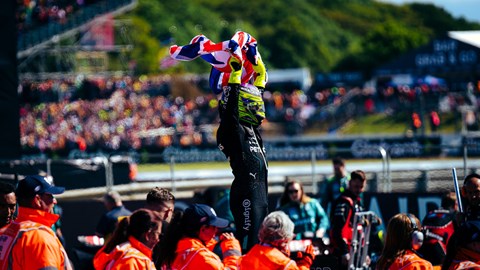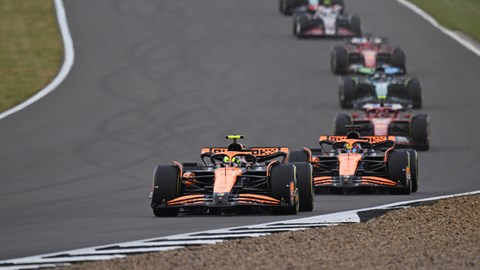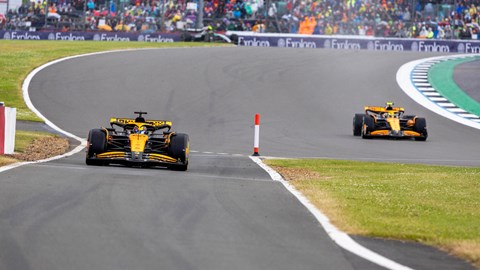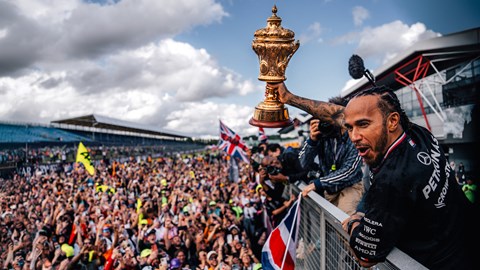► Hamilton’s first win in over two years
► Why it was one of the most important in his career
► Verstappen followed in second with Norris third
Lewis Hamilton has won this year’s British Grand Prix in a race that’ll go down as one of the best this season – and arguably one of the best in Silverstone’s F1 history. On paper, 104 gives Hamilton a spate of new records: he’s now the most successful driver at a single circuit with nine wins, the oldest winner in the 21st century at 39 years and 183 days, and the first win for a driver after their 300th start. It also gives him a pleasingly equal number of wins and poles.
That flurry of figures suggests yesterday’s win was just another 25 points for the Englishman, but clearly to him, the team and the crowd this meant so much more. Why? Because despite having 103 victories already in the books, Hamilton hasn’t won for a while.

Yesterday ended a 945-day barren period for Hamilton, a driver who has built a career on always finding a way to win. His winless period spanned from Abu Dhabi 2021 to July 2024 and packed in two years of relatively uncompetitive Mercedes cars, as well as a teammate who seems to enjoy driving this year’s car more. Little surprise then, that a feeling of excitement in the crowd was mixed with elements of relief and vindication. After the race, even Hamilton admitted to questioning his ability – such a key part of identity for F1 drivers – and said he wondered if he’d be able to do it again.
Was this expected?
Mercedes didn’t go into the weekend as favourites – with Hamilton arguably less likely to win than his teammate who won the Austrian GP a week before. In my preview, Guenther Steiner predicted this year’s race would be a fight between McLaren and Red Bull and I agreed – but as the weekend and the race wore on it increasingly felt like it could be another vintage Hamilton weekend.
First, Hamilton’s P2 with a race-focused set-up looked ominous. Couple that with a race that required tough strategy calls, speed in tricky conditions and the ability to preserve tyres whilst still putting in the laptimes, and this win seemed inevitable in retrospect.
The weekend
The Mercedes looked competitive all weekend, but it was yet again the McLaren that seemed to be the fastest car – especially with Norris at the helm. On Friday, fastest laps from Norris and Piastri whipped up a growing sea of orange flags and caps, and it looked like this was the race where Woking would finally capitalise on its recent speed. It didn’t happen in Austria, Canada or Spain – but this time the Papaya cars were set.

The Red Bull looked there or thereabouts, with Max dragging Newey’s last Milton Keynes creation to the top of the time sheets every so often.
Fast-forward to Saturday and it was somehow Mercedes who locked out the front row, with a strong performance from Russell and Hamilton (who admitted his car was more set up for the race). A disappointed Norris (a worryingly frequent sight this year) rounded out the British top three on the grid, with Verstappen behind in P4.
The race
As you’d expect from Silverstone, the weather was fickle in a way that caused difficulties for drivers, strategy teams and fans attending the race. Sunglasses or waterproofs? At Silverstone I’ve come to learn it’s somehow always both, and usually within minutes of each other.
That meant qualifying was precarious (as Perez found out after sliding into the gravel early on) and the race was no different. And three British drivers in the top three can do two things – either increase the chances of a Brit on the top step or reduce them threefold.

The Mercedes cars held station while it was dry, but then a rain shower jumbled up the field; first Hamilton overtook a struggling Russell on lap 18, then both McLarens came to life in the damp conditions and passed them both. Drivers scrabbled for grip on corner exits with both Norris, Hamilton and Russell all going straight on through corners at some point. Not long after, Piastri passed Norris for the lead. It’s these conditions I find most exciting, as you can really see the drivers’ ability in plain sight.
The question at the halfway point was when to pit for intermediate tyres, and this is where Piastri’s decision to pit a lap later cost him. Red Bull’s strategy team made the right call, though. The order at that point of the race was Norris, Hamilton, Verstappen and Russell, until the second Mercedes had to retire with a water system issue. But Silverstone still had one card left to play; beating hot sun!
On a track too wet for slicks but increasingly painful for inters, the drivers had to manage speed with degradation and time their jump to slicks perfectly. Too soon and they’d lose temperature and therefore grip and time – and worst-case scenario, fly off the track. Too late and they’d end up on slow, burnt intermediates. On track you could see the cars being coaxed into corners as their front tyres gradually dissolved. On the stands, you could see people working out if it was worth taking off their waterproofs this time. It was at this time that Hamilton’s superior tyre management began to play him into the victory.
Verstappen, Hamilton and Norris timed this juggling act perfectly, but there was a further question: which slick tyre compound? Verstappen went for hards that allowed him to push ‘til the end, Hamilton for fragile softs. Norris had a choice between new medium or softs and the chose the latter. This was the first factor that lost McLaren the win, as the medium proved to be faster (Piastri, Norris’s teammate was 10 seconds faster in 10 laps on the medium).
Norris was rightfully disappointed about this after the race, but it seemed a tad odd for McLaren to leave the decision entirely in his hands. After all, he’d have the least data to make the decision, and was pretty busy driving an F1 car at the time. Listen to the other teams’ radio messages and you’ll find more straightforward comms with more decisions made behind the pit wall. It felt like a team error rather than a Norris one.
The next factor? As Norris came in, he slightly misjudged his entry – easy on a slippery track – causing his McLaren mechanics to momentarily move and recalibrate. This handed Hamilton a 3-ish second lead. With ten laps to go and a faster car behind, Lewis had to manage his tyres whilst still eking out enough pace at bay. There was still another threat though; this time from old foe Verstappen who was taking chunks of time from both Norris and Hamilton. Norris was passed four laps from the end in a clean move, and then it was just down to Lewis to hold off Verstappen for the remainder.
The finish: a classic Silverstone dénouement
From 2007 to 2021 you’d have that nailed on as a Hamilton win, but in 2024 everything felt more precarious, so it was all the more rewarding when it happened again. As Hamilton rounded the final corner in a lap of nerves and catharsis for his fans, everything began to feel quite familiar and routine – crazy given the last two years, but obvious given the 15 before them.

After the race I managed to watch the podium, and saw Kimi Antonelli, the 17-year old hotly tipped for Lewis’s seat next year watching on beside me. He’d had a mixed weekend in the F2 but produced an incredible performance in Saturday’s race to win in tricky conditions.
Later, images of Hamilton crowd-surfing, spraying champagne and celebrating with a Union Flag played over the big screens while I struggled to leave the car park in my electric Jeep Avenger. For me at least, they proved a reminder that as exciting and talented as the new wave of British drivers are, Silverstone is still very much Sir Lewis Hamilton’s realm.